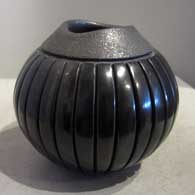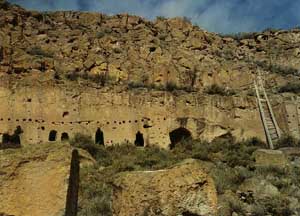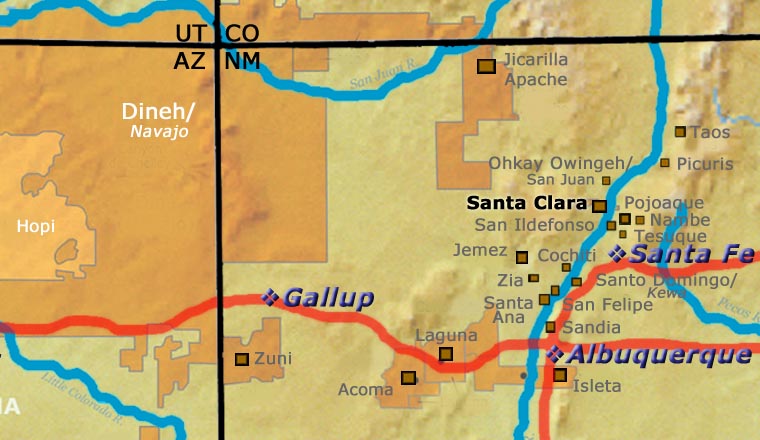
Linda Tafoya
Santa Clara

The daughter of Betty and Lee Tafoya, Linda Tafoya was born into Santa Clara Pueblo in 1962. As a granddaughter of Margaret Tafoya she grew up surrounded by some of the finest traditional potters on Earth and learned the Santa Clara way early in life, mostly from her parents and her aunt, Mary Esther Archuleta.
Linda made her first pieces when she was twelve years old. Her father taught her how to form vessels and carve them while her mother taught her sanding and polishing. Her father also taught her his method for firing a perfect black pot and maintaining its high shine. Pieces they worked on together were signed "Lee and Linda." Then she married Dennis Oyenque of San Juan Pueblo and moved there.
At San Juan she continued to make pottery the Santa Clara way but she also learned San Juan methods and imagery and was one of the first Santa Clara potters to use micaceous clay on her pieces.
Linda lived at San Juan through the 1980s, signing her pottery: Linda Tafoya-Oyenque, Santa Clara/San Juan. Then she divorced and returned to Santa Clara. At Santa Clara she remarried and became Linda Tafoya-Sanchez. She still creates traditional Santa Clara red and black pottery with some San Juan imagery. Deep carving, light carving, sgraffito, micaceous slips, red and black ware, Linda does it all, and with an exceptional polish, too. She also taught her sons, Antonio and Jeremy, the traditional way to make pottery.
Over the years Linda participated in a number of exhibits, fairs and shows, earning awards regularly from the Heard Museum Guild Indian Fair and Market, Santa Fe Indian Market, Eight Northern Pueblos Arts and Crafts Show and the Gallup Intertribal Ceremonials.
In 2006, Linda was featured on the cover of New Mexico Magazine and was a featured artist in the 2011 Santa Fe Indian Market Magazine.
After all she has accomplished in her career, Linda says one accolade in particular still warms her heart. Early in her career Margaret Tafoya, her grandmother, asked to see some of her pots. She says Margaret looked over her selection and then proclaimed: "You do good pots!" It doesn't get any better than that.
Some of Linda's Awards:
- 1984 - Outstanding Traditional Miniatures, Deer Dancer Annual Pottery Show, Denver, CO
- 1993 - First Place for a miniature melon jar, First Place for miniature miscellaneous, and Third Place for carved miscellaneous, all at Santa Fe Indian Market
- 1994 - First Place for black miniature jar, Second Place for miniature seed pot, and Third Place for a carved jar, all at Santa Fe Indian Market
- 1995 - Best of Division, Heard Museum Guild Indian Art Fair & Market, Scottsdale, AZ
- Geraldine Harris Memorial Award from the Heard - 1996 - Ribbons for traditional pottery over 6 inches and traditional miniature under 3 inches, both from Santa Fe Indian Market
- 1997 - Special Award in Traditional Pottery, Eight Northern Indian Pueblos Arts and Crafts Show, San Juan Pueblo
- Award from Santa Fe Indian Market in the Traditional Bowls and Vases category - 1998 - Best of Division, piece was presented to the Prince of Spain
- First Place for undecorated black melon bowl and jar, First Place for carved or incised bowl, both from Santa Fe Indian Market
- Best in Category at the Gallup Intertribal Ceremonials - 1999 - First Place for a miniature, First Place for a traditional pot, both from the Eight Northern Indian Pueblos Arts and Crafts Show
- 2023 - Best of Division, Pottery Division C: Traditional burnished black or red ware, incised, painted or carved, Santa Fe Indian Market
- 2023 - First Place, Pottery Division C, Category 702 - Carved or incised, black or red, over 8 inches tall, Santa Fe Indian Market
- 2024 - Best of Division Pottery, Classification IIC, Traditional Burnished Black or Red Ware, Incised, painted or carved, Santa Fe Indian Market
- 2024 - First Place, Pottery Classification IIC: Category 704 - Incised or Carved, Any form, Santa Fe Indian Market
- 2024 - Second Place, Classificatioon IIE: Category 904 - With added elements (like beads, feathers, stones, etc), any form
100 West San Francisco Street, Santa Fe, New Mexico 87501
(505) 986-1234 - www.andreafisherpottery.com - All Rights Reserved

Santa Clara Pueblo

Ruins at Puye Cliffs, Santa Clara Pueblo
Santa Clara Pueblo straddles the Rio Grande about 25 miles north of Santa Fe. Of all the pueblos, Santa Clara has the largest number of potters.
The ancestral roots of the Santa Clara people have been traced to ancient pueblos in the Mesa Verde region in southwestern Colorado. When that area began to get dry between about 1100 and 1300 CE, some of the people migrated eastward, then south into the Chama River Valley where they constructed several pueblos over the years. One was Poshuouinge, built about 3 miles south of what is now Abiquiu on the edge of the Jemez foothills above the Chama River. Eventually reaching two and three stories high, and with up to 700 rooms on the ground floor, Poshuouinge was occupied from about 1375 CE to about 1475. Drought then again forced the people to move, some of them going to the area of Puye (on the eastern slopes of the Pajarito Plateau of the Jemez Mountains) and others downstream to Ohkay Owingeh (San Juan Pueblo, along the Rio Grande). Beginning around 1580 CE, drought forced the residents of the Puye area to relocate closer to the Rio Grande and they founded what we now know as Santa Clara Pueblo on the west bank of the river, with San Juan Pueblo to the north and San Ildefonso Pueblo to the south.
In 1598 the seat of Spanish government was established at Yunque, near San Juan Pueblo. The Spanish proceeded to antagonize the Puebloans so badly that that government was moved to Santa Fe in 1610, for their own safety.
Spanish colonists brought the first missionaries to Santa Clara in 1598. Among the many things they forced on the people, those missionaries forced the construction of the first mission church around 1622. However, like the other pueblos, the Santa Clarans chafed under the weight of Spanish rule. As a result, they were in the forefront of the Pueblo Revolt of 1680. One Santa Clara resident, a mixed black and Tewa man named Domingo Naranjo, was one of the rebellion's ringleaders. However, the pueblo unity that allowed them to chase the Spanish out fell apart shortly after their success, especially after Popé died.
When Don Diego de Vargas came back to the area in 1694, he found most of the Santa Clarans on top of nearby Black Mesa (with the people of San Ildefonso). A six-month siege didn't subdue them so finally, the two sides negotiated a treaty and the people returned to their pueblos. However, successive invasions and occupations by northern Europeans took their toll on all the tribes over the next 250 years. Then the swine flu pandemic in 1918 almost wiped them out.
Today, Santa Clara Pueblo is home to as many as 2,600 people and they comprise probably the largest per capita number of artists of any North American tribe (estimates of the number of potters run as high as 1-in-4 residents).
Today's pottery from Santa Clara is typically either black or red. It is usually highly polished and designs might be deeply carved or etched ("sgraffito") into the pot's surface. The water serpent, (avanyu), is a very common traditional design motif on Santa Clara pottery. Another motif comes from the legend that a bear helped the people find water during a drought. The bear paw has appeared on much of their pottery ever since.
Santa Clara has received a lot of distinction because of the evolving artistry the potters have brought to their craft. Not only did this pueblo produce excellent black and redware, several notable innovations helped move pottery from the realm of utilitarian vessels into the domain of art. Different styles of polychrome redware emerged in the 1920s-1930s. In the early 1960s experiments with stone inlay, incising and double firing began. Modern potters have also extended the tradition with unusual shapes, slips and designs, illustrating what one Santa Clara potter said: "At Santa Clara, being non-traditional is the tradition." (This refers strictly to artistic expression; the method of creating pottery remains traditional).
Santa Clara Pueblo is home to a number of famous pottery families: Tafoya, Baca, Gutierrez, Naranjo, Suazo, Chavarria, Garcia, Vigil, and Tapia - to name a few.
100 West San Francisco Street, Santa Fe, New Mexico 87501
(505) 986-1234 - www.andreafisherpottery.com - All Rights Reserved

Margaret Tafoya Family Tree
Disclaimer: This "family tree" is a best effort on our part to determine who the potters are in this family and arrange them in a generational order. The general information available is questionable so we have tried to show each of these diagrams to living members of each family to get their input and approval, too. This diagram is subject to change should we get better info.
Note: Sarafina (Gutierrez) Tafoya was the sister of Pasqualita Tani Gutierrez.
- Sarafina Tafoya (1863-1949) & Geronimo Tafoya
- Margaret Tafoya (1904-2001) & Alcario Tafoya (d. 1995)
- Mary Ester Archuleta (1942-2010)
- Barry Archuleta
- Bryon Archuleta
- Sheila Archuleta
- Jennie Trammel (1929-2010)
- Karen Trammel Beloris
- Virginia Ebelacker (1925-2001)
- James Ebelacker (1960-) & Cynthia Ebelacker
- Jamelyn Ebelacker
- Sarena Ebelacker
- Richard Ebelacker (1946-2010) & Yvonne Ortiz
- Jason Ebelacker
- Jerome Ebelacker & Dyan Esquibel
- Andrew Ebelacker
- Nickolas Ebelacker
- James Ebelacker (1960-) & Cynthia Ebelacker
- Lee Tafoya (1926-1996) & Betty Tafoya (Anglo)
- Linda Tafoya (Oyenque)(Sanchez) (1962-)
- Phyllis Bustos Tafoya
- Mela Youngblood (1931-1990) & Walt Youngblood
- Nancy Youngblood (1955-)
- Christopher Cutler
- Joseph Lugo
- Sergio Lugo
- Nathan Youngblood (1954-)
- Nancy Youngblood (1955-)
- Toni Roller (1935-)
- Brandon Roller
- Cliff Roller (1961-)
- Deborah Morning Star Roller
- Jeff Roller (1963-)
- Jordan Roller
- Ryan Roller
- Susan Roller Whittington (1955-)
- Charles Lewis
- Tim Roller (1959-) & Clarissa Tafoya
- William Roller
- LuAnn Tafoya (1938-) & Sostence Tapia
- Michele Tapia Browning (1960-2025)
- Daryl Duane Whitegeese (1964-) & Rosemary Hardy
- Shirley Cactus Blossom Tafoya (1947-2010)
- Meldon Tafoya
- Mary Ester Archuleta (1942-2010)
- Christina Naranjo (1891-1980) & Jose Victor Naranjo (1895-1942)
- Mary Cain (1916-2010)
- Billy Cain (1950-2005)
- Joy Cain (1947-)
- Linda Cain (1949-)
- Autumn Borts-Medlock (1967-)
- Tammy Garcia (1969-)
- Douglas Tafoya
- Marjorie Tafoya Tanin
- Teresita Naranjo (1919-1999)
- Stella Chavarria (1939-)
- Denise Chavarria (1959-)
- Joey Chavarria (1964-1987)
- Sunday Chavarria (1963-)
- Stella Chavarria (1939-)
- Cecilia Naranjo
- Sharon Naranjo Garcia (1951-)
- Judy Tafoya (1962-) & Lincoln Tafoya (1954-)
- Mida Tafoya (1931-2024)
- Sherry Tafoya (1956-)
- Phyllis Tafoya (1955-)
- Robert Tafoya
- Ethel Vigil
- Kimberly Garcia
- Mary Cain (1916-2010)
- Camilio Tafoya (1902-1995) & Agapita Silva (1904-1959)
- Joe Tafoya & Lucy Year Flower (1935-2012)
- Kelli Little Kachina (1967-2014)
- Myra Little Snow (1962-)
- Forrest Red Cloud Tafoya
- Shawn Tafoya (1968-)
- Joseph Lonewolf (1932-2014) & Katheryn Lonewolf
- Greg Lonewolf (1952-)
- Rosemary Apple Blossom Lonewolf (1954-) & Paul Speckled Rock (1952-2017)
- Adam Speckled Rock
- Susan Romero
- Grace Medicine Flower (1938-)
- Joe Tafoya & Lucy Year Flower (1935-2012)
- Dolorita Padilla (1897-1960) & Alberto Padilla (1898-)
- Tomacita Tafoya Naranjo (1884-1918) & Agapita Naranjo
- Nicolasa Naranjo (c.1910-) & Jose G. Tafoya
- Howard Naranjo & Linda Naranjo
- Nicolasa Naranjo (c.1910-) & Jose G. Tafoya
Some of the above info is drawn from Pueblo Indian Pottery, 750 Artist Biographies, by Gregory Schaaf, © 2000, Center for Indigenous Arts & Studies
Other info is derived from personal contacts with family members and through interminable searches of the Internet.
(505) 986-1234 - www.andreafisherpottery.com - All Rights Reserved


